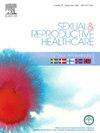Exploring midwives’ perceptions of the multisensory birthing room work environment: A qualitative analysis
IF 1.7
3区 医学
Q3 PUBLIC, ENVIRONMENTAL & OCCUPATIONAL HEALTH
引用次数: 0
Abstract
Background
Multisensory birthing rooms are specially designed and integrate elements such as sound, light, and visual stimuli to create an immersive atmosphere.
Aim
To investigate how implementing multisensory birthing rooms affect midwives’ perceptions of their working environment.
Methods
The data material consisted of 16 semi-structured interviews. The population was midwives employed before and after the implementation of multisensory birthing rooms and the setting was a labour ward unit at a Danish regional hospital. A qualitative description of the midwives’ perceptions of their working environment in multisensory birthing rooms was performed and a thematic analytical approach was applied.
Findings
Four major themes were identified. 1. “Sensing the environmental transformation” in which the midwives experienced that the multisensory birthing rooms helped to create a safe and less risk-focused atmosphere. 2. “Navigating new norms” describing the espoused beliefs and values regarding new practices within the rooms in which the implementation of the rooms creates a commitment among midwives for further involvement and development of the maternity ward. 3. “A supportive atmosphere”, which addresses how the multisensory birthing rooms capture different levels of affective attunement and how the calm atmosphere helps to support the work of the midwives. 4. “A sense of pride and empowerment”, which addresses how the environment creates a sense of pride and empowers the midwives.
Conclusions
The physical transformation from traditional to multisensory birthing rooms has led to a cultural transformation supporting the midwives’ sense of professionalism through the improved working environment.
探讨助产士对多感官产房工作环境的看法:一项定性分析。
背景:多感官产房是专门设计的,融合了声、光、视刺激等元素,营造出身临其境的氛围。目的:探讨多感官产房的实施对助产士工作环境的影响。方法:资料由16个半结构化访谈组成。人口是在实施多感官产房之前和之后雇用的助产士,地点是丹麦一家地区医院的分娩病房。对助产士对多感官产房工作环境的看法进行了定性描述,并采用了专题分析方法。确定了四个主要主题。1. “感知环境的转变”,助产士们体验到,多感官的产房有助于创造一种安全、低风险的氛围。2. “引导新规范”描述了在病房内关于新做法的支持信念和价值观,在病房的实施中,助产士承诺进一步参与和发展产科病房。3. “一个支持性的氛围”,阐述了多感官产房如何捕捉不同程度的情感调节,以及平静的氛围如何帮助支持助产士的工作。4. “自豪感和赋权感”,涉及环境如何创造自豪感并赋予助产士权力。结论:从传统产房到多感官产房的物理改造,带来了一种文化转型,通过改善工作环境来支持助产士的专业意识。
本文章由计算机程序翻译,如有差异,请以英文原文为准。
求助全文
约1分钟内获得全文
求助全文
来源期刊

Sexual & Reproductive Healthcare
PUBLIC, ENVIRONMENTAL & OCCUPATIONAL HEALTH-
CiteScore
2.70
自引率
5.60%
发文量
73
审稿时长
45 days
 求助内容:
求助内容: 应助结果提醒方式:
应助结果提醒方式:


